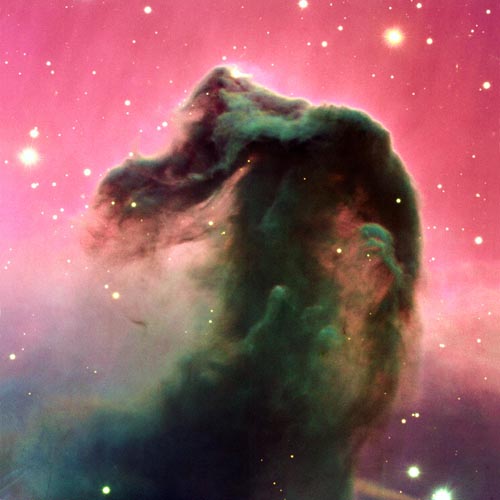
Dark Nebula
R.A. 05h 40m 59.00s Dec. -02° 27' 30.0"
Orion
About 490 pc (1,600 light-years)
Approximately 0.67 pc (2.2 light-years) horizontal
ESO
January 25, 2002
Normal: N0202 Closeup: N0112 Infrared: N1312 Related: N0949
ABOUT THIS IMAGE:
A new, high-resolution
color image of one of the most photographed celestial objects, the famous
"Horsehead Nebula" (IC 434) in Orion, has been produced from
data stored in the VLT Science Archive. The original CCD frames were obtained
in February 2000 with the FORS2 multi-mode instrument at the 8.2-m VLT
KUEYEN telescope on Paranal (Chile). The comparatively large field-of-view
of the FORS2 camera is optimally suited to show this extended object and
its immediate surroundings in impressive detail.
A spectacular object
The image shows the famous "Horsehead Nebula", which is situated in the Orion molecular cloud complex. Its official name is Barnard 33 and it is a dust protrusion in the southern region of the dense dust cloud Lynds 1630, on the edge of the HII region IC 434. The distance to the region is about 1400 light-years (430 pc).
This beautiful color image was produced from three images obtained with the multi-mode FORS2 instrument at the second VLT Unit Telescope ( KUEYEN ), some months after it had "First Light", cf. eso9944. The image files were extracted from the VLT Science Archive Facility and the photo constitutes a fine example of the subsequent use of such valuable data. Details about how the photo was made are available below.
The comparatively large field-of-view of the FORS2 camera (nearly 7 x 7 arcmin 2) and the detector resolution (0.2 arcsec/pixel) make this instrument optimally suited for imaging of this extended object and its immediate surroundings. There is obviously a wealth of detail, and scientific information can be derived from the colors shown in this photo. Three predominant colors are seen in the image: red from the hydrogen (H-alpha) emission from the HII region; brown for the foreground obscuring dust; and blue-green for scattered starlight.
The blue-green regions
of the Horsehead Nebula correspond to regions not shadowed from the light
from the stars in the H II region to the top of the picture and scatter
stellar radiation towards the observer; these are thus `mountains' of
dust . The Horse's `mane' is an area in which there is less dust along
the line-of-sight and the background (H-alpha) emission from ionized hydrogen
atoms can be seen through the foreground dust.
A chaotic area
At
the high resolution of this image the Horsehead appears very chaotic with
many wisps and filaments and diffuse dust . At the top of the figure there
is a bright rim separating the dust from the HII region. This is an `ionization
front' where the ionizing photons from the HII region are moving into
the cloud, destroying the dust and the molecules and heating and ionizing
the gas.
Dust and molecules can exist in cold regions of interstellar space which are shielded from starlight by very large layers of gas and dust. Astronomers refer to elongated structures, such as the Horsehead, as `elephant trunks' (never mind the zoological confusion!) which are common on the boundaries of HII regions. They can also be seen elsewhere in Orion - another well-known example is the pillars of M16 (the "Eagle Nebula") made famous by the fine HST image..
Such structures are
only temporary as they are being constantly eroded by the expanding region
of ionized gas and are destroyed on timescales of typically a few thousand
years. The Horsehead as we see it today will therefore not last forever
and minute changes will become observable as the time passes
The surroundings
To the east
of the Horsehead (at the bottom of this image) there is ample evidence
for star formation in the Lynds 1630 dark cloud . Here, the reflection
nebula NGC 2023 surrounds the hot B-type star HD 37903 and some Herbig
Haro objects are found which represent high-speed gas outflows from very
young stars with masses of around a solar mass.
The HII region to
the west (top of picture) is ionized by the strong radiation from the
bright star Sigma Orionis, located just below the southernmost star in
Orion's Belt. The chain of dust and molecular clouds are part of the Orion
A and B regions (also known as Orion's `sword').
Technical
information about the photos
ESO Press Photo
eso0202a was produced from three images, obtained on February 1, 2000,
with the FORS2 multi-mode instrument at the 8.2-m KUEYEN Unit Telescope
and extracted from the VLT Science Archive Facility. The frames were obtained
in the B-band (600 sec exposure; wavelength 429 nm; FWHM 88 nm; here rendered
as blue), V-band (300 sec; 554 nm; 112 nm; green) and R-band (120 sec;
655 nm; 165 nm; red) The original pixel size is 0.2 arcsec. The photo
shows the full field recorded in all three colors, approximately 6.5 x
6.7 arcmin 2. The seeing was about 0.75 arcsec. North is to the left and
east is down (the usual orientation for showing this object). The frames
were recorded with a TK2048 SITe CCD and the ESO-FIERA Controller, built
by the Optical Detector Team (ODT). The images were prepared by Cyril
Cavadore (ESO-ODT), by means of Prism software.